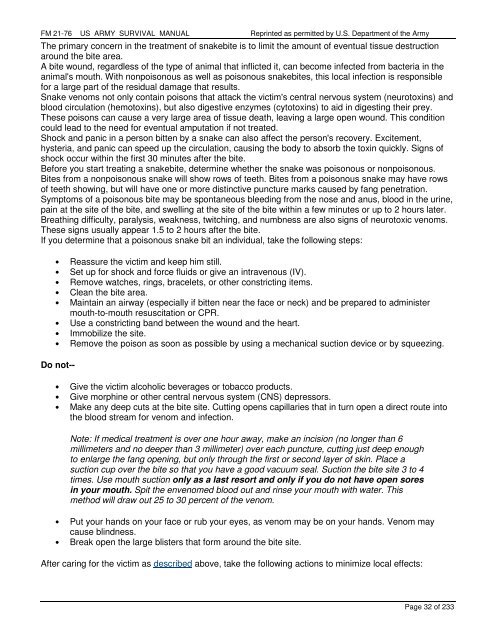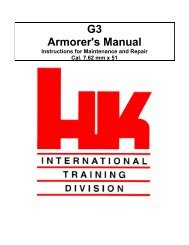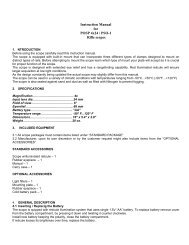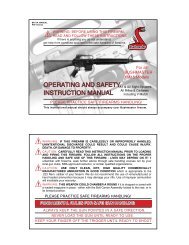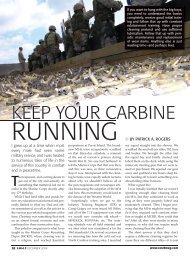FM 21-76 US ARMY SURVIVAL MANUAL - AR15.com
FM 21-76 US ARMY SURVIVAL MANUAL - AR15.com
FM 21-76 US ARMY SURVIVAL MANUAL - AR15.com
You also want an ePaper? Increase the reach of your titles
YUMPU automatically turns print PDFs into web optimized ePapers that Google loves.
<strong>FM</strong> <strong>21</strong>-<strong>76</strong> <strong>US</strong> <strong>ARMY</strong> <strong>SURVIVAL</strong> <strong>MANUAL</strong> Reprinted as permitted by U.S. Department of the Army<br />
The primary concern in the treatment of snakebite is to limit the amount of eventual tissue destruction<br />
around the bite area.<br />
A bite wound, regardless of the type of animal that inflicted it, can become infected from bacteria in the<br />
animal's mouth. With nonpoisonous as well as poisonous snakebites, this local infection is responsible<br />
for a large part of the residual damage that results.<br />
Snake venoms not only contain poisons that attack the victim's central nervous system (neurotoxins) and<br />
blood circulation (hemotoxins), but also digestive enzymes (cytotoxins) to aid in digesting their prey.<br />
These poisons can cause a very large area of tissue death, leaving a large open wound. This condition<br />
could lead to the need for eventual amputation if not treated.<br />
Shock and panic in a person bitten by a snake can also affect the person's recovery. Excitement,<br />
hysteria, and panic can speed up the circulation, causing the body to absorb the toxin quickly. Signs of<br />
shock occur within the first 30 minutes after the bite.<br />
Before you start treating a snakebite, determine whether the snake was poisonous or nonpoisonous.<br />
Bites from a nonpoisonous snake will show rows of teeth. Bites from a poisonous snake may have rows<br />
of teeth showing, but will have one or more distinctive puncture marks caused by fang penetration.<br />
Symptoms of a poisonous bite may be spontaneous bleeding from the nose and anus, blood in the urine,<br />
pain at the site of the bite, and swelling at the site of the bite within a few minutes or up to 2 hours later.<br />
Breathing difficulty, paralysis, weakness, twitching, and numbness are also signs of neurotoxic venoms.<br />
These signs usually appear 1.5 to 2 hours after the bite.<br />
If you determine that a poisonous snake bit an individual, take the following steps:<br />
• Reassure the victim and keep him still.<br />
• Set up for shock and force fluids or give an intravenous (IV).<br />
• Remove watches, rings, bracelets, or other constricting items.<br />
• Clean the bite area.<br />
• Maintain an airway (especially if bitten near the face or neck) and be prepared to administer<br />
mouth-to-mouth resuscitation or CPR.<br />
• Use a constricting band between the wound and the heart.<br />
• Immobilize the site.<br />
• Remove the poison as soon as possible by using a mechanical suction device or by squeezing.<br />
Do not--<br />
• Give the victim alcoholic beverages or tobacco products.<br />
• Give morphine or other central nervous system (CNS) depressors.<br />
• Make any deep cuts at the bite site. Cutting opens capillaries that in turn open a direct route into<br />
the blood stream for venom and infection.<br />
Note: If medical treatment is over one hour away, make an incision (no longer than 6<br />
millimeters and no deeper than 3 millimeter) over each puncture, cutting just deep enough<br />
to enlarge the fang opening, but only through the first or second layer of skin. Place a<br />
suction cup over the bite so that you have a good vacuum seal. Suction the bite site 3 to 4<br />
times. Use mouth suction only as a last resort and only if you do not have open sores<br />
in your mouth. Spit the envenomed blood out and rinse your mouth with water. This<br />
method will draw out 25 to 30 percent of the venom.<br />
• Put your hands on your face or rub your eyes, as venom may be on your hands. Venom may<br />
cause blindness.<br />
• Break open the large blisters that form around the bite site.<br />
After caring for the victim as described above, take the following actions to minimize local effects:<br />
Page 32 of 233


